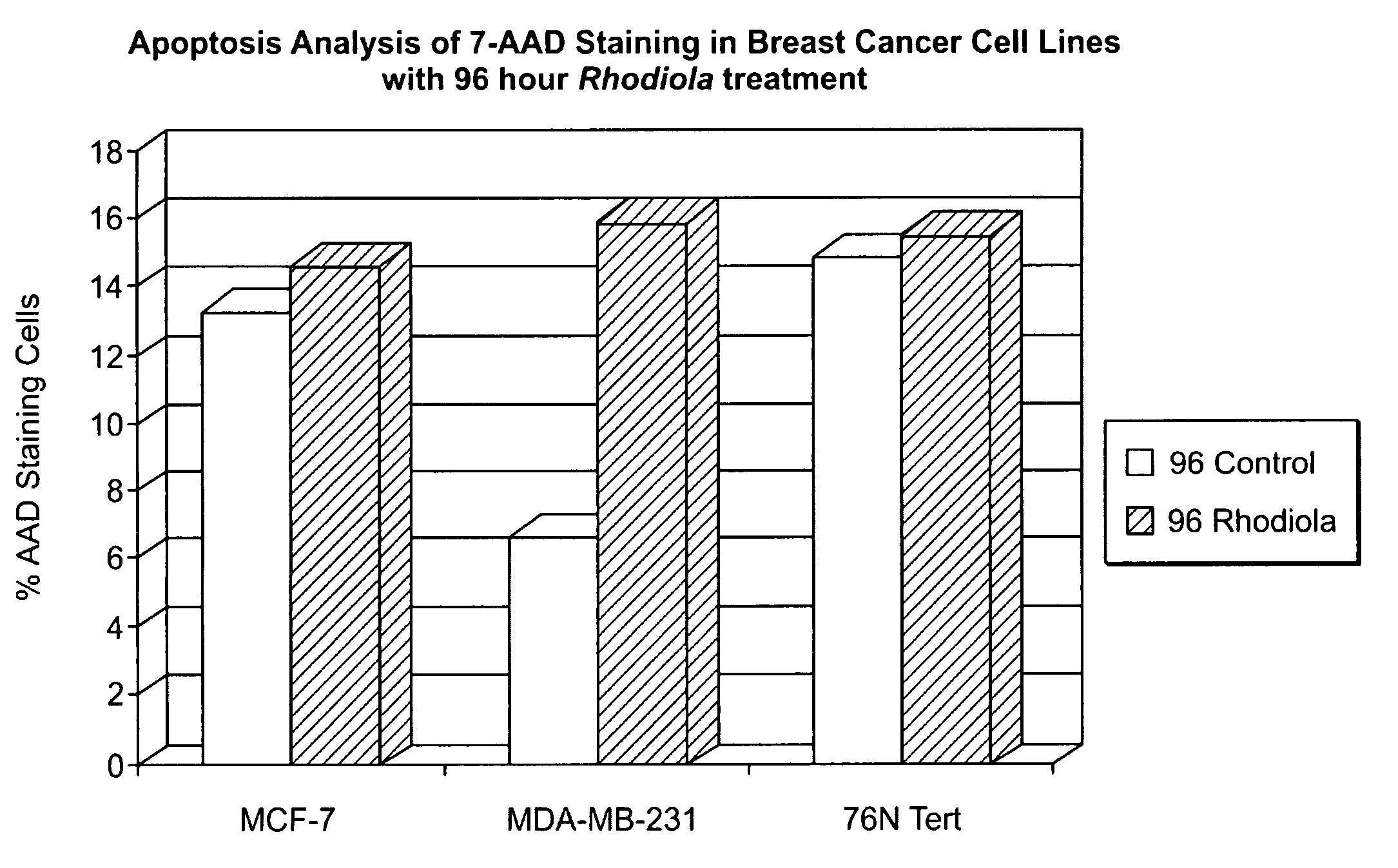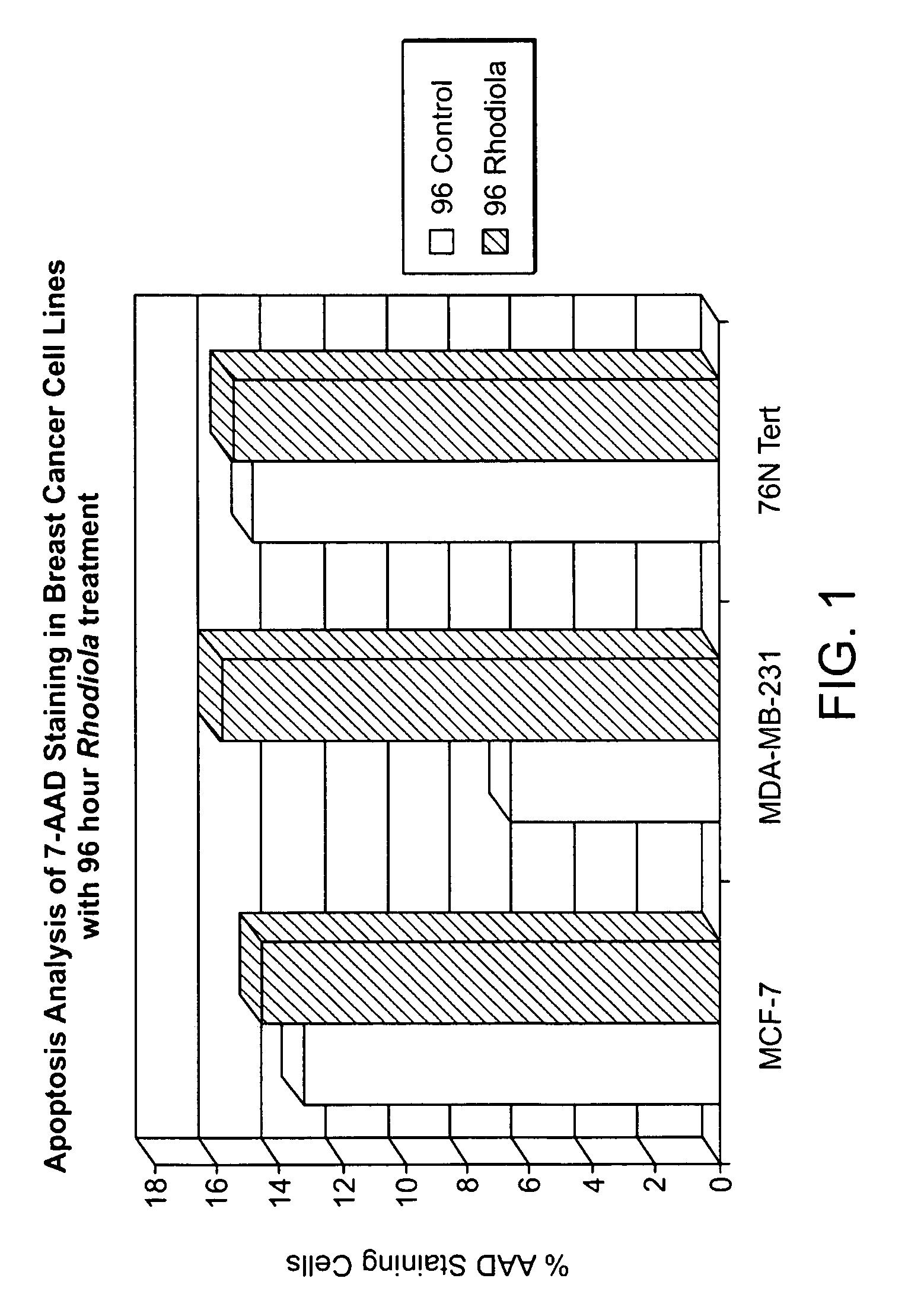Pharmaceutical formulations of rhodiola crenulata and methods of use thereof
a technology of rhodiola crenulata and pharmaceutical formulations, which is applied in the directions of biocide, plant/algae/fungi/lichens, drug compositions, etc., to achieve the effect of increasing the activity of ataxia telangiectasia mutated (atm) and increasing the activity of atm
- Summary
- Abstract
- Description
- Claims
- Application Information
AI Technical Summary
Benefits of technology
Problems solved by technology
Method used
Image
Examples
example 1
In vivo Effects of Dietary Rhodiola on Survival of V14 Carcinoma Mice
[0092]In vivo, dietary Rhodiola crenulata alone decreases the growth and enhances necrosis of an aggressive metastatic breast cancer cell line—V14. V14 cells have mutant p53 and are estrogen receptor-negative (ER(−)), and ErbB2-positive (Her-2(+)). They take on a spindle cell morphology in vivo reminiscent of cells which have undergone an epithelial to mesenchymal transition. Cancers of this type in humans are highly aggressive and resistant to many types of therapies. BALB / c mice were injected subcutaneously in the flank with V14 cells. After the tumor grew to ˜2-3 mm3 in size, the animals were administered water with or without 20 mg / kg / day Rhodiola crenulata extract and treated accordingly for the duration of the experiment. The mice were euthanized when the tumor reached 1 cm3. Subcutaneous injection of V14 cells into the flank caused growth of a tumor by approximately 10 days. The treatment significantly decre...
example 2
In vitro Growth Arrest of V14 Carcinoma Cells Treated With Rhodiola
[0094]As can be seen in FIG. 11, V14 cells treated with Rhodiola crenulata extract exhibited both anti-growth (i.e. growth arrest) and apoptotic effects over time in vitro. V14 cells were treated with 75 μg / mL Rhodiola and examined for their proliferative potential by 3H thymidine incorporation assays (or apoptotic potential by flow cytometry) at various time points. A greater anti-growth effect was noted in lines which were more sensitive to Rhodiola at lower doses, while the death looked similar. Since there were significant differences in the antioxidant enzymes and energy pathways between the two lines, this suggests that the oxidative state and energy production impacted the growth more than the death phenotype.
example 3
In vitro Apoptosis Study of V14 Carcinoma Cells Treated With Rhodiola
[0095]A dose of 75 μg / mL of Rhodiola extract was administered to V14 cells and the amount of apoptosis measured over time by staining with 7-Amino-Actinomycin D (7-AAD) which selectively stains dead cells, followed by flow cytometry analysis. As seen in FIG. 12, Rhodiola treatment induced programmed cell death in both V14 SCC9 cells (single cell clone 9) and V14 resistant cells (a cell line that has some resistance to certain Rhodiola effects) throughout the time course of the experiment, from 24 to 72 hours, although at 72 hours the level of apoptosis began to decrease somewhat in the V14 resistant cells. Hatched bars indicate untreated samples taken from an experiment performed on a different day from that involving treatment with Rhodiola extract.
PUM
 Login to View More
Login to View More Abstract
Description
Claims
Application Information
 Login to View More
Login to View More - R&D
- Intellectual Property
- Life Sciences
- Materials
- Tech Scout
- Unparalleled Data Quality
- Higher Quality Content
- 60% Fewer Hallucinations
Browse by: Latest US Patents, China's latest patents, Technical Efficacy Thesaurus, Application Domain, Technology Topic, Popular Technical Reports.
© 2025 PatSnap. All rights reserved.Legal|Privacy policy|Modern Slavery Act Transparency Statement|Sitemap|About US| Contact US: help@patsnap.com



